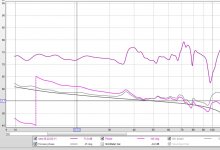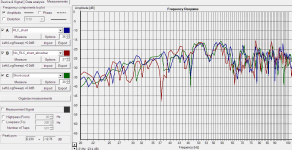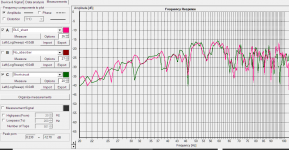Something like thisWhat was it like before they were in the room?
I definetly don't want carry them out in another room
No.Maybe that 45-70Hz dip is the effect of those boxes
That dip is the same without.
And that dip is the matter to read about absorbers
With quick and dirty DBA problem was partially solved.
2 front subs and 2 inverted delayed rear subs. Double bass array Double bass array - Wikipedia
Mic position exactly as in previous meas.
Like this now:
Mic position exactly as in previous meas.
Like this now:
Attachments
Last edited:
I like that it's a dipole of sorts and doesn't pressurise the room.
And that's good because:?
To "pressurize" a volume it must be sealed. If it is sealed you will eventually suffocate. I don't think many people can actually "pressurize" their listening rooms even with an array of monopoles.
prefer it.
"it", what is "it"? My point is that there can't be any "pressurization" so what exactly is "it" that you don't like?
And my point is that there is a degree of pressurisation as the cone moves out from a sealed box in my not quite sealed room. It's a small room, I've used both sealed and open baffle and it definitely feels different on my ears and feels like pressure, what else could it be?
It's not static pressure, I hope we can agree to that. What I find most people dislike in bass in rooms is a strong mode which creates a booming effect and maybe a feeling of "pressurization". This will not occur for a dipole if the mode is low enough in frequency, only a monopole will excite it. The solution is to EQ the room better so that this doesn't happen. The dipole can never be EQ'd to achieve the same response as a monopole in a small room, so a dipole not not really a solution, its a band-aid.
Yes of course.It's not static pressure, I hope we can agree to that.
This sounds like what I've experiencedWhat I find most people dislike in bass in rooms is a strong mode which creates a booming effect and maybe a feeling of "pressurization". This will not occur for a dipole if the mode is low enough in frequency, only a monopole will excite it.
Do you mean the same low frequency response of a monopole, say, below approx 40Hz. I appreciate a dipole isn't a solution to room modes, is that what you mean?The solution is to EQ the room better so that this doesn't happen. The dipole can never be EQ'd to achieve the same response as a monopole in a small room, so a dipole not not really a solution, its a band-aid.
I mean that dipole just cannot extend the bass to lower frequencies in a small room the way a monopole can. The bad rep that monopoles get is because they are not used properly and not because dipole are superior. My room only has monopoles and it has a nice smooth LF response down to 20 Hz - no dipole can do that. Of course It's not trivial to setup, but I get annoyed by implications that dipoles are somehow inherently superior because people have only heard inferior monopole setups.
Got L=4.7mH, R=2 ohm, C=470uF and did another set of measurements:
1. RLC_shunt vs. Short-circuit vs. No absorber
2. RLC_shunt vs. Short-circuit (for better visibility)
I would say that both short-circuit or RLC shunt look better than no absorber. And RLC shunt has a little margin over short-circuit as two dips look better. This is only measurement, I will go on listening the RLC thing too see if I can hear a difference.
1. RLC_shunt vs. Short-circuit vs. No absorber
2. RLC_shunt vs. Short-circuit (for better visibility)
I would say that both short-circuit or RLC shunt look better than no absorber. And RLC shunt has a little margin over short-circuit as two dips look better. This is only measurement, I will go on listening the RLC thing too see if I can hear a difference.
Attachments
Back to my first question :
My explanation : when you place this absorber or a passive resonator or absorbant in a corner (ie anything that has some acoustic inluence in low frequencies), this "absorber" can be considered as a re-radiating item. Generally its dimensions are smaller than the low frequencies wavelengths concerned. Due to the small dimensions, the directivity of the re-radiation is wide and so will influence and distord the original soundfield everywhere in the room.
Does this make sense ?
I think that found one explanation after a nice discussion with somebody who was active in the development of the AVAA from PSI : this active absorber is a nice tool to understand some acoustics because you can easily compare and measure when switching it on/off.we know that corners are places where all low frequency modes are present with max pressure and no velocity. For this reason, many people (and many books) say that basstraps are preferably placed in corners. This is also often said for fibrous materials (despite no velocity in corners). For sure, at opposite corner, the effect will be heard. But at listening place ?
My explanation : when you place this absorber or a passive resonator or absorbant in a corner (ie anything that has some acoustic inluence in low frequencies), this "absorber" can be considered as a re-radiating item. Generally its dimensions are smaller than the low frequencies wavelengths concerned. Due to the small dimensions, the directivity of the re-radiation is wide and so will influence and distord the original soundfield everywhere in the room.
Does this make sense ?
Yes but the modal pattern is changed due to the change of impedance at the corner.At low frequencies in a small room one cannot talk about "directivity, because waves can only follow the modal pattern
- Status
- This old topic is closed. If you want to reopen this topic, contact a moderator using the "Report Post" button.
- Home
- General Interest
- Room Acoustics & Mods
- Acoustics of corners



